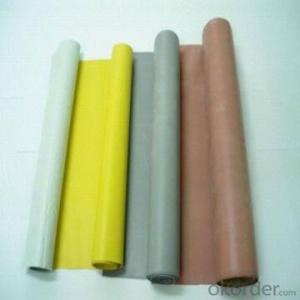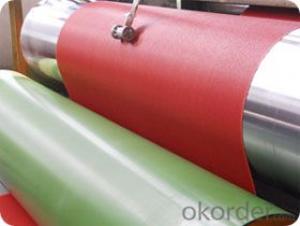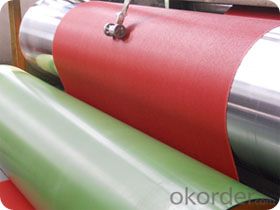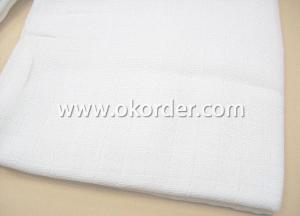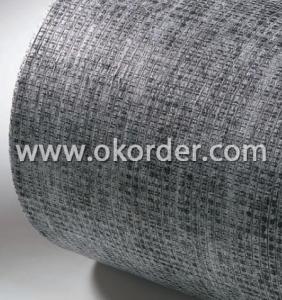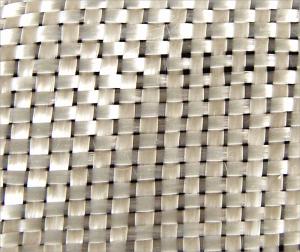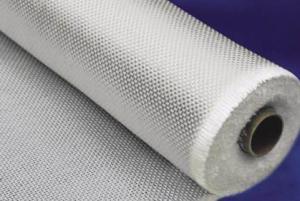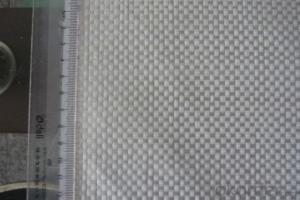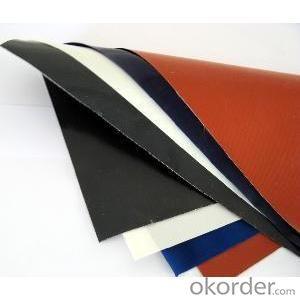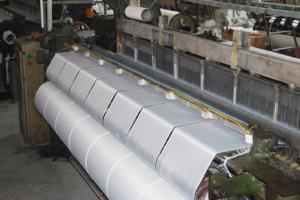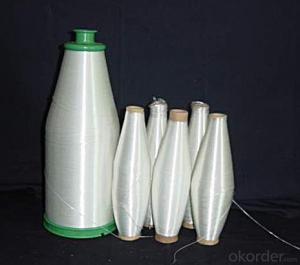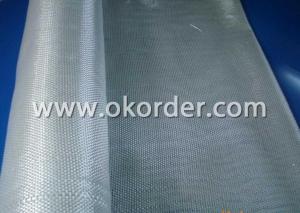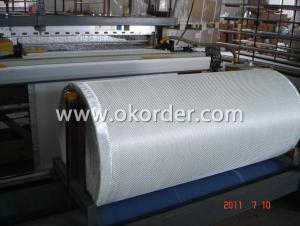Woven Roving Fiberglass Fabric Coated with Silicone Rubber 0.2mm-5mm
- Loading Port:
- Shanghai
- Payment Terms:
- TT OR LC
- Min Order Qty:
- 500 m²
- Supply Capability:
- 50000 m²/month
OKorder Service Pledge
OKorder Financial Service
You Might Also Like
Coated Fiberglass Fabric with Silicone Rubber 0.2mm-5mm
Fiberglass Fabric Description
Silicone coated fiberglass fabric is a fiberglass cloth, which possesses the properties of temperature resistance, anti-corrosion, high strength and is coated with organic silicone rubber.
Fiberglass Fabric Specification
Thickness:0.2mm-5mm
Width:100cm-150cm
Color;grey/red/silver/black
Weight(coating):130gsm-2800gsm
Model No | FSD2030 | FSD2030 | FSD2050 | FSD2100 | |
High temperature resistant(°C) | ≤280 | ≤280 | ≤280 | ≤280 | |
Low temperature resistant(°C) | ≥-40 | ≥-40 | ≥-40 | ≥-40 | |
Tensile intensity (N/50mm) | Warp | ≥1750 | ≥1750 | ≥2500 | ≥3500 |
Weft | ≥1280 | ≥1280 | ≥2100 | ≥3000 | |
Inflating burst intensity(Mpa) | ≥2.0 | ≥2.0 | ≥2.2 | ≥2.6 | |
Peeling intensity(N/m) | ≥450 | ≥450 | ≥520 | ≥600 | |
Insulation (kv/mm) | 16 | 16 | 18 | 18 | |
Weight (g/m*m) | 550-650 | 550-650 | 750-800 | 1500-1800 | |
Width(mm) | 1000±20 | 1000±20 | 1000±20 | 1000±20 | |
Thickness(mm) | 0.3-0.4 | 0.3-0.4 | 0.05-0.55 | 1.0-1.1 | |
color | Silver-gray, gray, red | lucency | Silver-gray, gray, red | Black, gray, red | |
Fiberglass Fabric Features:
1, Good performance on resisting high temperature and low temperature, -40°C-280°C;
2, High strength;
3, Ozone, oxide, light and weather aging resistance;
4, High insulation: dielectric constant:3-3.2, breakdown voltage: 20-50KV/MM;
5, Chemical corrosion resistant, oil-proofing, waterproofing (washable)
Fiberglass Fabric Application:
It has been widely used in construction, electric insulation,
chemical industry, pipeline ductile conjunction, large generating
Corrosion proofing field, machinery, metallurgy, sealing and so on.
Product Show
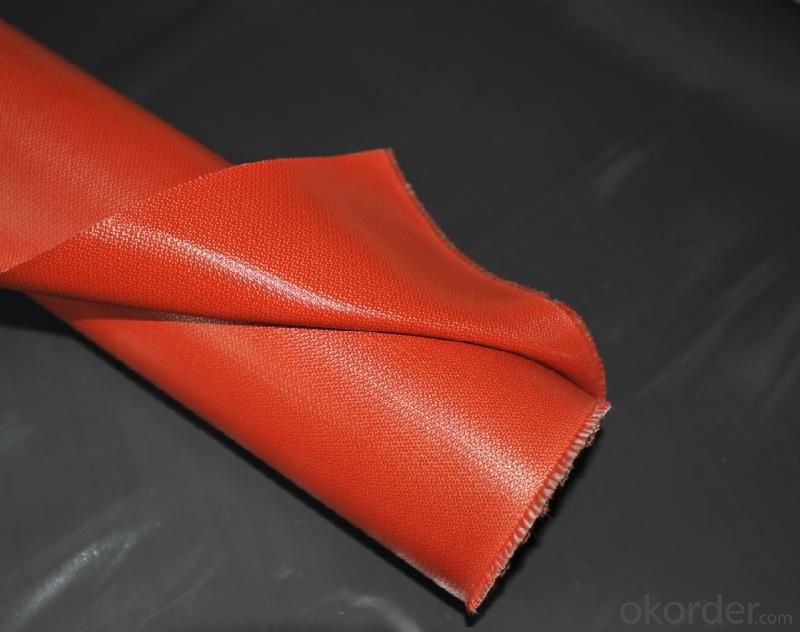

FAQ
1.What are the characteristics of fiberglass fabric?
a)Outstanding temperature resistance(from -70°C to +260°C)
b)Excellent chemical resistance
c)Superior non-stick surface, easy to clean
d)High dielectric strength
e)Dimensional stability
f)Resistance to UV, IR and HF
g)Non-toxic
2.How many methods to weave the fabric?
Four methods to weave the fabric:
a).Plain weave: it can be used in electricity insulation materials and reinforced materials in industry, because of inseparable structure, plain and clear lines.
b).Twill weave: compared with plain weave, it is of high density, high intensity, with a soft and loose structural weave. It can be used in ordinary reinforced materials, filter materials, and painting cloth.
c) Satin weave: compared with plain weave and twill weave, it is of high density,high intensity, with a soft and loose structural weave with a good texture. It is applicable for use as a higher reinforced material in machinery.
d).Gauze weave: said lattice twist weave. It can be used in spread model curtain,resin reinforced emery wheel gray cloth and lattice embed belt.
3.Can you offer us some samples?
We are willing to offer our customers best product&service,if it's necessary we can send
you sample for test;also we welcome all you customer have a trial order.
- Q: Can fiberglass fabric be used for making curtains or drapes?
- Yes, fiberglass fabric can be used for making curtains or drapes. It is a versatile material that offers several advantages such as durability, resistance to fire, and easy maintenance. It can also provide insulation, privacy, and block out excessive sunlight if desired. Additionally, fiberglass fabric is available in various colors and patterns, allowing for a wide range of design options for curtains or drapes.
- Q: What is the difference between alkali resistant fiberglass mesh and hot dipped galvanized steel wire mesh?
- Alkali resistant fiberglass mesh cloth softer can only play the deformation of dispersing stress (deformation temperature, deformation and outside) to plaster layer sharing under tension. When the glass fiber cloth mass per unit area increases, the tensile bond strength of tile is bigger, but the increase is not obvious. When the glass fiber cloth mesh size increases, the tensile bond strength of brick decreased after increasing.
- Q: What are the different coating options available for fiberglass fabric?
- There are several coating options available for fiberglass fabric. These coatings are designed to enhance the fabric's properties and make it suitable for various applications. 1. Silicone Coating: Silicone coating provides excellent heat resistance and can withstand high temperatures. It also offers good chemical resistance, making it suitable for applications in industries such as aerospace, automotive, and insulation. 2. Polyurethane Coating: Polyurethane coating provides a durable and flexible finish to fiberglass fabric. It offers good abrasion resistance, waterproofing, and UV stability. This coating is commonly used in applications like outdoor covers, tents, and awnings. 3. PTFE Coating: PTFE (Polytetrafluoroethylene) coating is known for its non-stick properties and high resistance to chemicals, heat, and weathering. It provides excellent electrical insulation and low friction properties. PTFE coated fiberglass fabric is commonly used in applications such as conveyor belts, release sheets, and insulation. 4. Acrylic Coating: Acrylic coating provides a smooth finish and enhances the fabric's durability and strength. It offers good resistance to UV rays, mildew, and abrasion. This coating is commonly used in applications like marine covers, outdoor furniture, and bags. 5. Neoprene Coating: Neoprene coating provides excellent resistance to oil, chemicals, and weathering. It also offers good flame resistance and flexibility. This coating is commonly used in applications such as protective clothing, gloves, and industrial curtains. 6. Vinyl Coating: Vinyl coating provides a waterproof and durable finish to fiberglass fabric. It offers good resistance to UV rays, abrasion, and chemicals. This coating is commonly used in applications like outdoor furniture, truck covers, and pool liners. These are just a few examples of the different coating options available for fiberglass fabric. The choice of coating depends on the specific requirements of the application, such as heat resistance, chemical resistance, flexibility, and durability.
- Q: How is fiberglass fabric used in the automotive industry?
- Fiberglass fabric is widely used in the automotive industry for various applications due to its unique properties. One of the main uses of fiberglass fabric in this industry is for manufacturing car parts such as body panels, hoods, and spoilers. Fiberglass fabric is chosen for these applications because it is lightweight, strong, and durable. This material offers excellent strength-to-weight ratio, which means it can provide high strength to the car parts without adding excessive weight. This is crucial for improving fuel efficiency and overall performance of the vehicle. Moreover, fiberglass fabric is also used in the automotive industry for insulation purposes. It is commonly used to insulate engine components, such as exhaust systems and heat shields, to protect surrounding parts from excessive heat. The high temperature resistance of fiberglass fabric makes it an ideal choice for these applications. In addition, fiberglass fabric is utilized in the manufacturing of automotive interiors. It is commonly used for upholstery, door panels, headliners, and trunk liners. The fabric offers excellent flexibility, allowing it to conform to different shapes and contours of the car interior. Furthermore, it is resistant to stains, chemicals, and fading, ensuring a long-lasting and aesthetically pleasing interior finish. Furthermore, fiberglass fabric is also used for reinforcement purposes in the automotive industry. It is often applied as a layer in the production of composite materials used for making car parts. By combining fiberglass fabric with resins or other materials, manufacturers can create strong and rigid components that are resistant to impact, vibrations, and other external forces. Overall, fiberglass fabric plays a vital role in the automotive industry by providing lightweight, durable, and heat-resistant solutions for various applications. Its versatility and exceptional properties make it an ideal material for manufacturing car parts, insulation, interiors, and reinforcement, contributing to the efficiency, safety, and overall quality of vehicles.
- Q: Can fiberglass fabric be used for making tents?
- Yes, fiberglass fabric can be used for making tents. It is a popular choice for tent materials due to its lightweight, durable, and waterproof properties. Fiberglass fabric is resistant to various weather conditions and can provide good insulation.
- Q: What are the different weights or thicknesses available for fiberglass fabrics?
- There are various weights or thicknesses available for fiberglass fabrics, ranging from lightweight options like 3 oz per square yard to heavier options like 18 oz per square yard.
- Q: What are the different thicknesses of fiberglass fabric used in insulation?
- The different thicknesses of fiberglass fabric used in insulation can vary depending on the specific application and desired level of thermal resistance. Generally, fiberglass fabric for insulation purposes is available in a range of thicknesses, typically starting from 1 inch (25mm) and going up to 4 inches (100mm) or more. However, it's important to note that the specific thicknesses available may vary among manufacturers and regions. The chosen thickness is determined by factors such as the desired insulation R-value, the space available for insulation installation, and the specific requirements of the building or project. Thicker fiberglass fabric generally provides higher thermal resistance, which results in better insulation performance, effectively reducing heat transfer and energy loss. However, thicker insulation also requires more space for installation and may be costlier. Therefore, it's crucial to consider the specific needs and constraints of the project to determine the appropriate thickness of fiberglass fabric for insulation.
- Q: Can fiberglass fabric be used for reinforcement?
- Yes, fiberglass fabric can be used for reinforcement. It is commonly used in various industries such as construction, automotive, aerospace, and marine for reinforcing materials like composites, concrete, plastics, and even paper. The high strength, durability, and resistance to heat and chemicals make fiberglass fabric an ideal choice for reinforcement purposes.
- Q: What are the different weaving patterns available for fiberglass fabric?
- Fiberglass fabric comes in various weaving patterns, each with its distinct qualities and uses. The plain weave is the most fundamental and widely employed pattern. It involves a simple interlacing of warp and weft yarns, resulting in a balanced and uniform fabric structure. This type of fiberglass fabric offers good strength, dimensional stability, and versatility for different applications. Twill weave, on the other hand, creates a diagonal pattern on the fabric surface. By passing the weft yarn over multiple warp yarns before going under, this weaving technique enhances the fabric's drapability, flexibility, and ability to conform to complex shapes. Twill weave fiberglass fabric is commonly chosen for applications that require both durability and flexibility, such as in the aerospace and automotive industries. Satin weave is characterized by long floats, where the weft yarn passes over multiple warp yarns before going under. This creates a smooth and glossy surface with reduced crimp and higher yarn density. Satin weave fiberglass fabric is known for its excellent drapeability, high strength-to-weight ratio, and is often used in industries that demand a high-quality surface finish, such as marine and sporting goods. Leno weave is a unique pattern where the warp yarns are twisted together, resulting in an open and flexible structure. This weaving pattern enhances the fabric's breathability and allows for better resin impregnation during composite fabrication. Leno weave fiberglass fabric finds utility in filtration, reinforcement in composites, and as a base fabric for laminates. Finally, jacquard weave is a complex pattern achieved by controlling each warp yarn individually. This weaving technique allows for intricate designs, patterns, and textures to be woven into the fabric. Although less common in fiberglass fabric, jacquard weave can be used to create custom designs or specific functional features in specialized applications. In conclusion, the choice of weaving pattern for fiberglass fabric depends on the desired properties, performance requirements, and intended applications. Each pattern brings unique characteristics and advantages, providing numerous possibilities for utilizing fiberglass fabric across various industries.
- Q: How does fiberglass fabric handle moisture and humidity?
- Fiberglass fabric is known for its excellent resistance to moisture and humidity. Unlike other materials, it does not absorb water or become weakened or damaged by exposure to moisture. This makes it highly durable and suitable for applications in high-humidity environments or areas prone to moisture.
Send your message to us
Woven Roving Fiberglass Fabric Coated with Silicone Rubber 0.2mm-5mm
- Loading Port:
- Shanghai
- Payment Terms:
- TT OR LC
- Min Order Qty:
- 500 m²
- Supply Capability:
- 50000 m²/month
OKorder Service Pledge
OKorder Financial Service
Similar products
Hot products
Hot Searches
Related keywords
